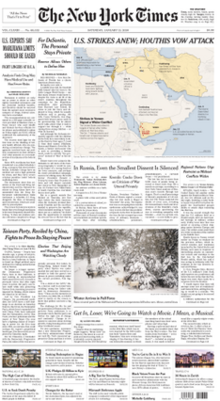News Articles for Dummies
Wiki Article
Indicators on News Articles You Should Know
Table of ContentsThe Definitive Guide for News ArticlesThe Facts About News Articles UncoveredThe smart Trick of News Articles That Nobody is Talking AboutThe Best Guide To News ArticlesThe Single Strategy To Use For News Articles
Great understanding of various subjects provides students an affordable side over their peers. Although electronic and social media sites are easily obtainable, we should not forget exactly how essential it is to read the newspapers. Moms and dads need to attempt and inculcate the practice of reviewing a newspaper as an everyday regimen to continue the heritage of the revered print medium.Newspaper article likewise contain at least one of the complying with essential qualities about the desired target market: distance, prestige, timeliness, human interest, strangeness, or effect. The associated term journalese is sometimes made use of, typically pejoratively, to refer to news-style writing. Another is headlinese. Papers normally stick to an expository writing style.
Within these restrictions, news tales likewise aim to be extensive. Amongst the bigger and more highly regarded newspapers, fairness and balance is a major aspect in presenting info.
Papers with a worldwide target market, for instance, often tend to utilize a much more official style of composing. News Articles.; typical design guides consist of the and the United States News Style Book.
The Buzz on News Articles
As a guideline, journalists will certainly not make use of a long word when a brief one will certainly do. News writers attempt to avoid utilizing the exact same word a lot more than once in a paragraph (in some cases called an "resemble" or "word mirror").
However, headings in some cases leave out the subject (e.g., "Leaps From Watercraft, Catches in Wheel") or verb (e.g., "Pet cat lady lucky"). A subhead (additionally subhed, sub-headline, subheading, caption, deck or dek) can be either a secondary title under the primary headline, or the heading of a subsection of the article. It is a heading that comes before the main message, or a group of paragraphs of the primary text.

Additional billboards of any of these kinds might appear later on in the post (specifically on succeeding web pages) to entice further analysis. Such billboards are likewise used as guidelines to the short article in various other areas of the publication or site, or as ads for the item in various other magazine or sites. Typical structure with title, lead paragraph (recap in vibrant), other paragraphs (details) and contact info.

Example of a hard-lead paragraph NASA is suggesting one more room task. The firm's budget demand, introduced today, included a plan to send another objective to the Moon. This time around the agency wants to establish a lasting center as a jumping-off place for various other space adventures. The budget demands approximately $10 billion for the job.
The NASA news came as the firm requested $10 billion of appropriations for the project. An "off-lead" is the 2nd crucial front page news of the day. The off-lead shows up either in the leading left corner, or directly below the lead on the right. To "bury the lead" index is to begin the short article with background info or details of secondary More about the author relevance to the readers, forcing them to read even more deeply into a post than they should have to in order to discover the essential points.
News Articles Things To Know Before You Buy
Typical usage is that or more sentences each create their own paragraph. Reporters normally define the organization or framework of a newspaper article as an inverted pyramid. The necessary and most interesting components of a story are placed at the beginning, with sustaining info following in order of lessening importance.It permits individuals to explore a topic to just the depth that their inquisitiveness takes them, and without the charge of information or nuances that they could think about pointless, however still making that details readily available to a lot more interested readers. The upside down pyramid structure likewise makes it possible for posts to be trimmed to any arbitrary size during format, to suit the area readily available.
Some authors start their tales with the "1-2-3 lead", yet there are several type of lead offered. This layout invariably starts with a "Five Ws" opening paragraph (as described over), followed by an indirect quote that offers to sustain blog a major component of the initial paragraph, and after that a straight quote to sustain the indirect quote. [] A kicker can refer to numerous points: The last tale in the news program; a "happy" tale to finish the program.
Longer write-ups, such as publication cover short articles and the pieces that lead the inside areas of a newspaper, are called. Feature stories differ from straight information in several means. Foremost is the lack of a straight-news lead, a lot of the moment. As opposed to offering the essence of a tale in advance, function writers might attempt to entice visitors in.
Not known Factual Statements About News Articles
The journalist usually information interactions with interview topics, making the piece a lot more personal. A feature's first paragraphs often associate an appealing moment or event, as in an "anecdotal lead". From the details of an individual or episode, its view rapidly widens to generalizations regarding the story's subject. The section that indicates what a feature has to do with is called the or signboard.
The Editor's Tool kit: A Referral Overview for Beginners and Professionals (2001) Allan M. Siegal and William G. Connolly. The New York Times Manual of Design and Usage: The Official Style Guide Utilized by the Writers and Editors of the Globe's The majority of Authoritative Paper (2002) M. L. Stein, Susan Paterno, and R.
Report this wiki page